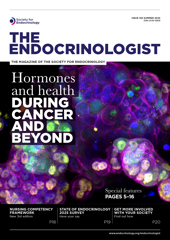Richard Anderson is Professor of Clinical Reproductive Science at the University of Edinburgh, and a consultant at the Royal Infirmary of Edinburgh. He also provides a specialist endocrinology service to the Edinburgh Gender Identity Clinic. He was founding Co-ordinator of the European Society of Human Reproduction Embryology Special Interest Group in Fertility Preservation, and is a member of the Human Fertilisation and Embryology Authority (HFEA) Scientific and Clinical Advances Advisory Committee.
What inspired you to study reproductive health?
My introduction to scientific research came about through an honours year as a medical student in the Department of Pharmacology in Edinburgh. During that time, I did a project in the MRC Brain Metabolism Unit, then directed by George Fink. This was eye-opening, and I was asked by George if I wanted to stay on to do a PhD, which I did under the supervision of Rory Mitchell. We studied the potential role of GABA in neuroendocrine regulation within the hypothalamus and pituitary, which was a great introduction to how the reproductive system is controlled.
Going back to third year medicine was a bit of a shock after that, but my attachment in obstetrics and gynaecology gave me a first glimpse of what reproductive medicine might be like. I decided to try to make that my career, taking up a SHO post in the Royal Infirmary and the Simpson Memorial Maternity Pavilion. This allowed interactions with the work at the then Centre for Reproductive Biology (CRB). I went on to do a two-year post as a Research Fellow with Fred Wu in the MRC Reproductive Biology Unit, working on a World Health Organization clinical trial in male contraception. That area (and indeed male reproductive endocrinology) has continued to be a significant focus of my work, recently with a trial using testosterone/nestorone gel run by the National Institutes of Health and the Population Council.
During that time, I got to know David Baird and subsequently undertook subspecialty training in reproductive medicine as a lecturer in obstetrics and gynaecology within the CRB, supervised by David. Those were great years, very busy at work with training in reproductive medicine, on-call obstetrics and gynaecology and research work, as well as family life with the birth of my two daughters. I subsequently spent a year in Sam Yen’s lab in San Diego (the highlight was living in south California), before returning as a consultant in the MRC Unit, and starting my current post in the University in 2005.
Tell us about your research on cancer treatments and female fertility
Working with David was an introduction to the early days of ovarian tissue cryopreservation for fertility preservation for cancer patients. We developed this clinically from the mid-1990s, with great support from Professor Hamish Wallace in paediatric oncology.
‘I hope that those starting their careers will have opportunities to test the research waters, as combining research with clinical practice has been a huge privilege, and great fun.’
The field of fertility preservation has become an increasing focus of my work since then, leading the ovarian tissue cryopreservation programme. This led to the first birth in the UK for the first woman whose ovarian tissue we replaced, after 11 years in cryostorage. That was a wonderful occasion, and I went to see David to tell him about it. His characteristically gruff response was, ‘What took you so long?’ (despite his obvious pleasure at the news).
Working with Hamish, analysing long-term reproductive outcomes of girls across south-east Scotland who had had cancer, allowed us to examine the criteria for offering ovarian tissue cryopreservation. We had initially developed these in the absence of any evidence, so it was very reassuring to see how this translated into identifying the right patients.
In parallel with this, I was working with David Cameron at the Edinburgh Breast Clinic, exploring the potential value of anti-Müllerian hormone to predict and assess the ovarian toxicity of cancer treatments, and we continue to refine this. The initial study we undertook was a five-year prospective study in women newly diagnosed with breast cancer, so it took a long time to generate data. This was possible with support from being in the MRC Unit.
What are the biggest challenges in this area?
A key aspect that we have particularly focused on is identifying the right patients who may need a fertility preservation intervention. One way we have approached this is by using Scottish national databases for cancer and maternity to identify, on an unbiased population basis, the impact of cancer and its treatment on whether (or not) women subsequently have a baby. This has also allowed us to show that having a baby after breast cancer was not associated with increased mortality, even in women with oestrogen receptor-positive disease.
What exciting developments are happening in the field?
It has also been very rewarding working with Evelyn Telfer in her work on in vitro follicle growth. The next step is whether the mature oocytes that are generated can be successfully fertilised, and we have an application for this under review by the HFEA at the moment.
What advice would you have given your younger self?
I consider myself enormously lucky to have had the opportunity to work in two MRC units, and particularly to have worked in the CRB under its various names. This environment, where it is completely natural for clinicians and discovery scientists to be rubbing shoulders daily, has been very rewarding, and I continue to lead some lab-based research. The decision to take four years out of my medical undergraduate studies is one that I have never regretted, although I suspect my parents rather despaired that I would ever complete my medical degree. I hope that those starting their careers will have opportunities to test the research waters, as combining research with clinical practice has been a huge privilege, and great fun.






